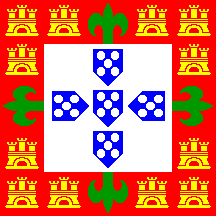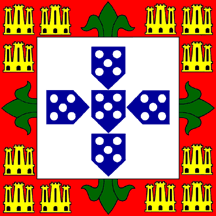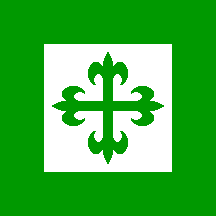 klaus-michael schneider
klaus-michael schneider
Keywords: portuguese youth | portuguese legion | cross(avis) | castles(12) | castle(yellow) | national federation for joy at work |
Links: FOTW homepage | search | disclaimer and copyright | write us | mirrors

Last modified: 2024-11-23 by  klaus-michael schneider
klaus-michael schneider
Keywords: portuguese youth | portuguese legion | cross(avis) | castles(12) | castle(yellow) | national federation for joy at work |
Links: FOTW homepage |
search |
disclaimer and copyright |
write us |
mirrors
![[Portugal national flag]](../images/p/pt.gif) 2:3, image by Vítor Luís and António Martins-Tuválkin, 23 Sep 2004
2:3, image by Vítor Luís and António Martins-Tuválkin, 23 Sep 2004
![União Nacional [PT]](../images/p/pt}un.gif)
The National Union was the only permitted political party during the New State rule of António de Oliveira Salazar. The party was established in 1930, had officially never been a political party, but an "organisation of the unity of all Portuguese". As such UN "won" all elections between 1934 and 1973, gaining all the seats in the national assembly. It was renamed into National People's Action (Acção Nacional Popular) and dissolved after the revolution of carnations in 1974.
The party had a white square flag with a blue bordure and five blue inescutcheons ordered per cross, each of them bearing five plates ordered in quincunx.
Klaus-Michael Schneider, 23 Dec 2014
![Acção Nacional Popular [PT]](../images/p/pt}anp!.gif)
The National Union was renamed in its 1970 congress. This modernisation attempt disappeared also the paramilitary emblematics of its previous incarnation. In the 1973 elections its leaflets and posters included a stylised "V" in a ribbon-like design, red/orange with two green stripes (or rather with five alternating red/orange and green stripes). Two of green and three of red is also the ration of the colours of the national flag, and I am sure that this was not a coincidence . A substitutional flag pattern emerging from this stylised ribbon (not even an actual flagoid) is speculative. The party would disappear with the Carnation Ravolution on 25 April 1974.
Learn more here and here
António Martins-Tuválkin, 9 Dec 2017

Flag of Mocidade Portuguesa, the regime’s youth organization.
Its is a banner of the arms, very similar to the royal flag of
1385-1433, but with only five bezants in each
eschuteon (normalization to current heraldry) and
with these in pentagonal
shape (due to the late art nouveau / fascist-modernist inclinations
of the regime artists). There were probably a lot more flags of this
organization (rank and unit banners), but I have no information about it.
António Martins, 4 Dec 1998

This is the version according to the official movement emblem.
António Martins-Tuválkin, 17 Feb 2005
Today attached photos of portuguese flags in the national Stadium in 1944
showing Portuguese Youth guidons fixed to the stadium infrastructure on a row of poles
where the national flag is also hoisted, several times. I think this is
noteworthy for two reasons: Hoisting of several national flags, in a way
usually felt to be trivializing (not unusual nowadays in Portugal but
unexpected for 1944), and hoisting of the national flag along and at the
same visual rank as a "lesser" organizational flag . This may be due to
recklessness, but the latter excusable in the sense that the Portuguese
Youth guidon is essentially the "national" flag of 1385-1485, and
as such arguably equivalent to the current/contemporary national flag.
António Martins-Tuválkin, 8 Feb 2009

Legião Portuguesa, a paramilitary organization set by the Salazar regime
in the late 20ies, if I recall correctly, and lasted until 1974. It’s flag is
a banner of the arms of «argent, a cross fleury vert
(Avis Order Cross), a bordure of the same». There
were probably a lot more flags of this organization (rank and
unit banners), but I have no information about it.
Photographic evidence shows that the shade of green is dark, matching the national flag, and that the
bordure thickness is 10% of the flag´s height.
Source: this photo
António Martins-Tuválkin, 4 Dec 1998 / 9 Dec 2017
.gif)
As already presented FNAT was rebranded in 1975 as Inatel
(Instituto Nacional Aproveitamento Tempos Livres dos Trabalhadores); it was originally inspired in Italian,
Soviet, and German counterparts, according to source.
The arms of FNAT are Sable on a cogwheel Argent five escutcheons Azure per cross each charged with five plates per saltire and for crest a rooster crowing Proper on a sunburst Or. The original idea and 1st depiction was devised in 1935 by Affonso de Dornellas, noted heraldist, and was made official in 1937. A more refined depiction was later created by Almeida Langhans, dito, and adopted in 1944. Both versions of the emblem are though found in use after 1944.
.gif)
image by António Martins-Tuválkin, 26 Feb 2010
This 2nd version added an oval seal-rim-like "scroll"Â all around the Coat of Arms,
compounded by a voided cartouche edged in stylized sunflower and wheat,
based on actual Lisbon Cruz de Pedra fountain stonework.
![[FNAT flag (PT)]](../images/p/pt}fnat.gif) 3:4 image by António Martins-Tuválkin, 26 Feb 2010 |
![[FNAT flag (PT)]](../images/p/pt}fnat2.gif) 1:1 image by António Martins-Tuválkin, 26 Feb 2010 |
back to Portugal Political Flags main page click here